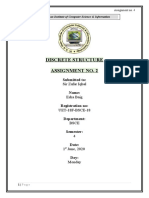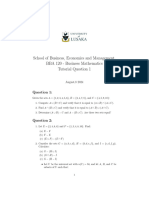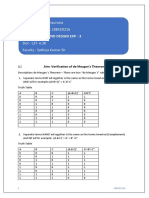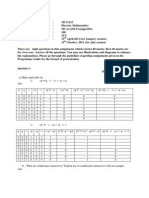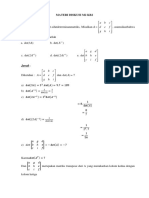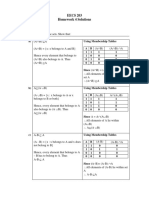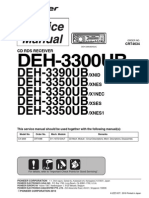CS 210 Assignment2 27100134
CS 210 Assignment2 27100134
Uploaded by
arktic.tech1Copyright:
Available Formats
CS 210 Assignment2 27100134
CS 210 Assignment2 27100134
Uploaded by
arktic.tech1Original Title
Copyright
Available Formats
Share this document
Did you find this document useful?
Is this content inappropriate?
Copyright:
Available Formats
CS 210 Assignment2 27100134
CS 210 Assignment2 27100134
Uploaded by
arktic.tech1Copyright:
Available Formats
CS-210 Discrete Mathematics LUMS
CS-210 Homework 2
Meesum Ali Student ID: 27100134
21 September 2024
1 Problem 1
Collaborated with: X,Y,Z.
1. Since P represents the power set, so P (X ∩ Y ) is the set of all subsets of (X ∩ Y ). So, we can write it as:
A = P (X ∩ Y ) ={S | S ⊆ (X ∩ Y )}.
Similarly for B, we can write it as;
B = P (X) ∩ P (Y ) = {S | S ⊆ (P (X) ∩ P (Y ))}
Since A = P (X ∩ Y ) is the set of all subsets of X ∩ Y or S ⊆ (P (X) ∩ P (Y )), While on the other hand
B = P (X) ∩ P (Y ) is the set of all subsets of X and Y, (or S ⊆ X ∩ S ⊆ Y ).
Since a set S ⊆ (X ∩ Y ) is exactly the same as a set that is a subset of both X and Y, we can conclude:
P (X ∩ Y ) = P (X) ∩ P (Y ) or we can say that A = B.
Hence Proved.
2 Problem 2
Collaborated with: X,Y,Z.
We will start by applying gates in the numbering they’re mentioned.
1. Input: A
Output : A
2. Input: C
Output: C
3. Input: B, C
Output: B.C
4. Input: B, C
Output: B.C
5. Input: B,C
Output: B.C
6. Input: A, (B.C)
Output : A.(B.C)
7. Input: A, (B. C)
Output : A . (B. C)
8. Input: A, (B.C)
Output: A.(B.C)
9. Input: A.(B.C), A.(B.C)
Output: A.(B.C) + A.(B.C)
Meesum Ali: 27100134@lums.edu.pk 1
CS-210 Discrete Mathematics LUMS
10. Input: A.(B.C) + A.(B.C), A.(B.C)
Output: ( A.(B.C) + A.(B.C)) + A.(B.C)
Now we simplify the expressions:
(B.C).(A + A) + A.(B.C) (Distributive Laws)
(B.C).(T ) + A.(B.C) (Negation Laws)
And finally, the expression becomes:
(B.C) + A.(B.C) (Identity Laws)
B.(C + (A.C))(Distributive Laws)
B.((C + A).(C + C)) (Distribuitve Laws)
B.((C + A).T ) (Negation Laws)
B.(C + A) (Identity Laws)
The circuit diagram will be:
Figure 1: Image of new circuit.
3 Problem 3
Collaborated with: X,Y,Z.
1. From LHS and RHS:
(P → R) ∨ (Q → R) ≡ (P ∧ Q) → R
(¬P ∨ R) ∨ (¬Q ∨ R) ≡ ¬(P ∧ Q) ∨ R (Implication Laws)
(¬P ∨ ¬Q) ∨ R ≡ (¬P ∨ ¬Q) ∨ R (Distributive law on LHS and DeMorgan’s Law on RHS)
(¬P ∨ ¬Q) ∨ R ≡ (¬P ∨ ¬Q) ∨ R
Hence Proved.
2. From LHS and RHS:
P ∧ (Q ∨ R) ≡ (P ∧ Q) ∨ (P ∧ R)
P ∧ (Q ∨ R) ≡ P ∧ (Q ∨ R) (Distributive Law)
Hence Proved.
3. The expression is:
¬[¬[(P ∨ Q) ∧ R] ∨ ¬Q] ≡ Q ∧ R
¬[¬(P ∨ Q) ∨ ¬R ∨ ¬Q] ≡ Q ∧ R (DeMorgan’s Law)
Meesum Ali: 27100134@lums.edu.pk 2
CS-210 Discrete Mathematics LUMS
¬[(¬P ∧ ¬Q) ∨ ¬R ∨ ¬Q] ≡ Q ∧ R (DeMorgan’s Law)
¬[(¬P ∧ ¬Q) ∨ ¬Q ∨ ¬R] ≡ Q ∧ R
¬[¬Q ∨ ¬R] ≡ Q ∧ R (Absorption Law)
[Q ∧ R] ≡ Q ∧ R
Hence Proved.
4. From LHS and RHS:
(P ∨ Q ∨ R) ∧ (P ∨ T ∨ ¬Q) ∧ (P ∨ ¬T ∨ R) ≡ P ∨ [R ∧ (T ∨ ¬Q)]
Taking LHS:
P ∨ [(Q ∨ R) ∧ (¬T ∨ R)] ∧ (P ∨ (T ∨ ¬Q)) (Distributive law)
P ∨ [(Q ∨ R) ∧ (¬T ∨ R) ∧ (T ∨ ¬Q)](Distributive law)
P ∨ [R ∧ (Q ∧ ¬T ) ∧ (T ∨ ¬Q)] (Distributive Law)
P ∨ [R ∧ (T ∨ ¬Q)] ∧ [(T ∨ ¬Q) ∧ (¬T ∨ Q)] (Distributive law)
P ∨ [R ∧ (T ∨ ¬Q)] ∨ [(T ∨ ¬Q) ∧ Q) ∧ ¬T ] (Distributive Law)
P ∨ [R ∧ (T ∨ ¬Q)] ∨ (T ∧ Q) ∨ (Q ∧ ¬Q)¬T (Distributive Law )
P ∨[R ∧ (T ∨ ¬Q)] ∨ [F alse ∧ (Q ∧ T ) ∧ ¬T ](Idempotentlaw)
P ∨[R ∧ (T ∨ ¬Q)] ∨ [(T ∧ Q) ∧ ¬T ] (Identity law)
P ∨ [R ∧ (T ∨ ¬Q)] ∨ [F alse ∧ Q] (Negation law)
P ∨ [R ∧ (T ∨ ¬Q)] ∨ F alse (Domination law)
P ∨ [R ∧ (T ∨ ¬Q)] (Identity law)
Hence L.H.S = R.H.S
4 Problem 4
Collaborated with: X,Y,Z.
1. We want to prove that :
(A ∪ B ∪ C)′ = A′ ∩ B ′ ∩ C ′
Let U be the universal set containing all possible elements relevant to sets A, B, and C.
Element A B C A′ B′ C′ A∪B∪C (A ∪ B ∪ C)′ A′ ∩ B ′ ∩ C ′
1 1 1 1 0 0 0 1 0 0
2 1 1 0 0 0 1 1 0 0
3 1 0 1 0 1 0 1 0 0
4 1 0 0 0 1 1 1 0 0
5 0 1 1 1 0 0 1 0 0
6 0 0 1 1 1 0 1 0 0
7 0 1 0 1 0 1 1 0 0
8 0 0 0 1 1 1 0 1 1
Table 1: Membership table for sets A, B, and C (4.1)
From the membership table, we can see that: (A ∪ B ∪ C)′ = A′ ∩ B ′ ∩ C ′
2. We want to prove that
′
((A ∩ B) ∪ (A′ ∩ C)) = (A ∩ B ′ ) ∪ (A′ ∩ C ′ )
Meesum Ali: 27100134@lums.edu.pk 3
CS-210 Discrete Mathematics LUMS
Element A B C A′ B′ C′ A∩B A′ ∩ C (A ∩ B) ∪ (A′ ∩ C)
1 1 1 1 0 0 0 1 0 1
2 1 1 0 0 0 1 1 0 1
3 1 0 1 0 1 0 0 0 0
4 1 0 0 0 1 1 0 0 0
5 0 1 1 1 0 0 0 1 1
6 0 1 0 1 0 1 0 0 0
7 0 0 1 1 1 0 0 1 1
8 0 0 0 1 1 1 0 0 0
Table 2: calculations for ((A ∩ B) ∪ (A′ ∩ C)) (4.2)
Let U be the universal set containing all possible elements relevant to sets A, B, and C.
Next, we need to compute the complement of ((A ∩ B) ∪ (A′ ∩ C)):
′
Element (A ∩ B) ∪ (A′ ∩ C) ((A ∩ B) ∪ (A′ ∩ C))
1 1 0
2 1 0
3 0 1
4 0 1
5 1 0
6 0 1
7 1 0
8 0 1
Table 3: ((A ∩ B) ∪ (A′ ∩ C))′ (4.3)
Now computing the right side (A ∩ B ′ ) ∪ (A′ ∩ C ′ ):
Element A B C A′ B′ C′ A ∩ B′ A′ ∩ C ′ (A ∩ B ′ ) ∪ (A′ ∩ C ′ )
1 1 1 1 0 0 0 0 0 0
2 1 1 0 0 0 1 0 0 0
3 1 0 1 0 1 0 1 0 1
4 1 0 0 0 1 1 1 0 1
5 0 1 1 1 0 0 0 0 0
6 0 1 0 1 0 1 0 1 1
7 0 0 1 1 1 0 0 0 0
8 0 0 0 1 1 1 0 1 1
Table 4: Calculations for (A ∩ B ′ ) ∪ (A′ ∩ C ′ ) (4.3)
Therefore, we conclude that:
′
((A ∩ B) ∪ (A′ ∩ C)) = (A ∩ B ′ ) ∪ (A′ ∩ C ′ )
3. First from LHS: (A\C) ∪ (B\C)
We say that there is an element x such that:
x ∈ (A\C) or x ∈ (B\C). This means the x ∈ / C and that x could be in A or B.
Therefore we can simplify the expression to:
x ∈ (A ∪ B)\C. Which is the RHS.
Thus we can say that (A\C) ∪ (B\C) ⊆ (A ∪ B)\C.
Meesum Ali: 27100134@lums.edu.pk 4
CS-210 Discrete Mathematics LUMS
Now from RHS:
Now consider an element y, such that y ∈ (A ∪ B) and y ∈ / C, then;
If y ∈ A and y ∈
/ C, then y ∈ A\C, or if y ∈ B and y ∈ / C, then we can say that:
y ∈ (A\C) ∪ (B\C), which follows that:
(A ∪ B)\ ⊆ (A\C) ∪ (B\C).
And since both sides are subsets of eachother, it follows that LHS = RHS.
4. The given equation is :
((A ∪ C) ∩ B)′ = B ′ ∪ (C ′ ∩ A′ )
From LHS:
= (A ∪ C)′ ∪ B ′ (DeMorgan’s Laws)
= B ′ ∪ (A ∪ C)′
= B ′ ∪ (A′ ∩ C ′ ) (DeMorgan’s Laws)
Hence Proved.
5. (((A ∪ B) ∩ C)′ ∪ B ′ )′ = B ∩ C
expanding the compliments on LHS:
= ( ((A ∪B) ∩ C)′ ∪ B ′ )′
= ( (A ∪B)′ ∪ C ′ ∪ B ′ )′ (DeMorgan’s Law)
= ((A′ ∩ B ′ ) ∪ C ′ ∪ B ′ )′ (DeMorgan’s Law)
= ((A′ ∩ B ′ ) ∪ B ′ ∪ C ′ )′
= (B ′ ∪ C ′ )′ (Absorption Law)
= B ∩ C (DeMorgan’s Law)
= R.H.S. Hence Proved.
Meesum Ali: 27100134@lums.edu.pk 5
You might also like
- Probability and Statistics in Engineering - Hines, Montgomery, Goldsman, Borror 4e Solutions (Thedrunkard1234)Document222 pagesProbability and Statistics in Engineering - Hines, Montgomery, Goldsman, Borror 4e Solutions (Thedrunkard1234)hrishi50% (2)
- 28 Ton Grove RT528CDocument8 pages28 Ton Grove RT528CLeo Villa100% (4)
- 2023 Oct CSC510 Test 1 Answer SchemeDocument5 pages2023 Oct CSC510 Test 1 Answer SchemeAzmina NajwaNo ratings yet
- Discrete Structure Assignment No. 2: Submitted ToDocument13 pagesDiscrete Structure Assignment No. 2: Submitted ToeshaNo ratings yet
- Chapter 1Document46 pagesChapter 1Nero5thNo ratings yet
- Hw2sol PDFDocument5 pagesHw2sol PDFelenaNo ratings yet
- DM AssignmentDocument23 pagesDM AssignmentRiha RahmanNo ratings yet
- Discrete Structures 4Document11 pagesDiscrete Structures 4Abdul BasitNo ratings yet
- HomeworkDocument15 pagesHomeworkvulephuong04No ratings yet
- Past Paper 10015 21 - SDocument32 pagesPast Paper 10015 21 - SYang ZhouNo ratings yet
- DLDADocument30 pagesDLDAManoj NaikNo ratings yet
- Lab 05-Set Operations: Objective Current Lab Learning Outcomes (LLO)Document5 pagesLab 05-Set Operations: Objective Current Lab Learning Outcomes (LLO)hexaNo ratings yet
- Homework 1 Outline of SolutionsDocument7 pagesHomework 1 Outline of SolutionsJeff SchulthiesNo ratings yet
- (MATH2111) (2017) (F) Final In5mue 14501Document12 pages(MATH2111) (2017) (F) Final In5mue 14501ngaiyishun1No ratings yet
- (MATH2111) (2019) (Sum) Final Em872 55599Document15 pages(MATH2111) (2019) (Sum) Final Em872 55599ngaiyishun1No ratings yet
- Tugas KB-1 Aljabar ModernDocument10 pagesTugas KB-1 Aljabar Modernabd rahmanNo ratings yet
- BBA120 Tutorial Sheet 1Document4 pagesBBA120 Tutorial Sheet 1chilupeesnartNo ratings yet
- Text (Vector Space)Document15 pagesText (Vector Space)colindanielblassingameNo ratings yet
- Solved Quiz1 PDFDocument4 pagesSolved Quiz1 PDFKushank JaiswalNo ratings yet
- Introduction To Neutrosophic BCI/BCK-AlgebrasDocument14 pagesIntroduction To Neutrosophic BCI/BCK-AlgebrasDon HassNo ratings yet
- 3.2: Truth Tables and Propositions Generated by A SetDocument3 pages3.2: Truth Tables and Propositions Generated by A Setpearl ikebuakuNo ratings yet
- Mathematics For A+ StudentsDocument5 pagesMathematics For A+ Studentsstephonhr14No ratings yet
- Chapter 2: Boolean Algebra & Logic Gates Solutions of Problems: Problem: 2-1Document7 pagesChapter 2: Boolean Algebra & Logic Gates Solutions of Problems: Problem: 2-1GHULAM MOHIUDDINNo ratings yet
- Solution CH 02 Part 3Document6 pagesSolution CH 02 Part 3Hanan AliNo ratings yet
- Cse1003 DLD LabDocument14 pagesCse1003 DLD LabPranav Chaurasia 18BCE0216No ratings yet
- 02 2 디지털논리 Boolean algebra2Document17 pages02 2 디지털논리 Boolean algebra2오현진No ratings yet
- ITC161 Assignment 1: Computers & Data & Digital LogicDocument6 pagesITC161 Assignment 1: Computers & Data & Digital LogicBrad GoddardNo ratings yet
- Self Assesment 2-Logic and Set Theory-1Document2 pagesSelf Assesment 2-Logic and Set Theory-1emmastark2773No ratings yet
- Set Equality ProvingDocument1 pageSet Equality ProvinglsasunanNo ratings yet
- Lecture 3Document25 pagesLecture 3api-3729886No ratings yet
- Tutorial Set 2Document4 pagesTutorial Set 2samuelkeithchewNo ratings yet
- Problem Set 1 SolutionsDocument2 pagesProblem Set 1 SolutionsMengyao MaNo ratings yet
- EST SolutionDocument10 pagesEST Solutionvp2005rawalNo ratings yet
- MA 106: Linear Algebra Tutorial 4: Prof. B.V. Limaye IIT DharwadDocument6 pagesMA 106: Linear Algebra Tutorial 4: Prof. B.V. Limaye IIT Dharwadamar BaroniaNo ratings yet
- Section A:: Problem 1Document8 pagesSection A:: Problem 1Prabin GcNo ratings yet
- Combinational LogicDocument46 pagesCombinational Logicamrit saudNo ratings yet
- QPhys PS4Document2 pagesQPhys PS4Resting BeastNo ratings yet
- 121Lab5Soln PDFDocument3 pages121Lab5Soln PDFAna WinterNo ratings yet
- Ignou Mca Mcs-013 Solved Assignment 2011Document15 pagesIgnou Mca Mcs-013 Solved Assignment 2011Meera Sukhesh100% (1)
- Some Properties of Fuzzy Set.: A B B A A B B ADocument9 pagesSome Properties of Fuzzy Set.: A B B A A B B ARajesh kumarNo ratings yet
- Set TheoryDocument61 pagesSet TheoryRushikesh PatilNo ratings yet
- SNU 2019 ExamsDocument43 pagesSNU 2019 ExamsSamuel MergaNo ratings yet
- Lecture 3: Boolean Algebra I The Basics: Learning OutcomesDocument8 pagesLecture 3: Boolean Algebra I The Basics: Learning OutcomesBenjhon S. ElarcosaNo ratings yet
- 9-Adder CircuitDocument3 pages9-Adder CircuitJay VenturaNo ratings yet
- Answers - Digital FundamentalsDocument6 pagesAnswers - Digital FundamentalsDOOAMADAANo ratings yet
- PhDpre Math-7Document4 pagesPhDpre Math-7aye pyoneNo ratings yet
- M2 KB2Document5 pagesM2 KB2ViLya Kudu WiLujénkNo ratings yet
- Chapter 4 - Logic and BooleanDocument3 pagesChapter 4 - Logic and BooleanSandesh GiriNo ratings yet
- Chapter 1Document40 pagesChapter 1AmritNo ratings yet
- Solution 4Document5 pagesSolution 4Abel MesfinNo ratings yet
- Basic AlgebraDocument2 pagesBasic AlgebraABHINAV NEGINo ratings yet
- Lecture 3Document16 pagesLecture 3manish bhattNo ratings yet
- FuzzyDocument8 pagesFuzzyosman.osmanNo ratings yet
- Discrete Mathematics Chapter II Sets Theory Lesson 4 Algebra of SetsDocument9 pagesDiscrete Mathematics Chapter II Sets Theory Lesson 4 Algebra of Setsあなたを 食べたい鮎麻呂No ratings yet
- Shah Scauu PDFDocument4 pagesShah Scauu PDFmatthew matthewNo ratings yet
- Dlda May19 SolutionDocument23 pagesDlda May19 Solutionpanigrahysagar7No ratings yet
- Discrete Math Sets 1Document3 pagesDiscrete Math Sets 1Guru DevNo ratings yet
- Experiment # 2 To Understand Laws of Boolean Algebra: ObjectiveDocument14 pagesExperiment # 2 To Understand Laws of Boolean Algebra: Objectivesyed waheedNo ratings yet
- Topic 1: MATH1081 Problem SolutionsDocument18 pagesTopic 1: MATH1081 Problem SolutionsjakeNo ratings yet
- Lucius Maximus Ballast ManualDocument8 pagesLucius Maximus Ballast Manualstraw manNo ratings yet
- 2b RectifierDocument21 pages2b RectifierLove Strike100% (1)
- f2209 Tampines ST 95 - 96Document11 pagesf2209 Tampines ST 95 - 96techsantonyNo ratings yet
- Star Rating ListDocument2 pagesStar Rating Listasingh gNo ratings yet
- Cement Calculus 28Document2 pagesCement Calculus 28PedjaNo ratings yet
- Software Requirements Specification For: COMSATS University Islamabad, Park Road, Chak Shahzad, Islamabad PakistanDocument44 pagesSoftware Requirements Specification For: COMSATS University Islamabad, Park Road, Chak Shahzad, Islamabad PakistanaddiNo ratings yet
- جديد كبارى-1 LRFDDocument35 pagesجديد كبارى-1 LRFDamaary31No ratings yet
- Fire QAPDocument2 pagesFire QAPSuryadev singhNo ratings yet
- TRAC-40GN Tandem Specs-1000units-REF077-20221004 (OP2)Document2 pagesTRAC-40GN Tandem Specs-1000units-REF077-20221004 (OP2)nguyennguyen05072000No ratings yet
- Ethernet I/P Best Practices & TopologiesDocument68 pagesEthernet I/P Best Practices & TopologiesmeledathNo ratings yet
- K20 Engine Control Module X1Document4 pagesK20 Engine Control Module X1Data TécnicaNo ratings yet
- LG 32LX2RDocument64 pagesLG 32LX2Ranon_49680389No ratings yet
- Awp Syllabus SoftDocument3 pagesAwp Syllabus Softpriyakanthr5883No ratings yet
- Quick Reference-Precise 100 SeriesDocument2 pagesQuick Reference-Precise 100 SeriesDragan IvanovNo ratings yet
- Fletcher Auditory PatternsDocument20 pagesFletcher Auditory Patternsantibombe100% (1)
- 2 - BS1377-9 - 1990 Clause 4.3Document6 pages2 - BS1377-9 - 1990 Clause 4.3Sydney MozerNo ratings yet
- Pioneer Deh-3300 3350 3390ubDocument64 pagesPioneer Deh-3300 3350 3390ubjmbernal7487886No ratings yet
- UCS30 ManualDocument53 pagesUCS30 Manualpedro1600No ratings yet
- A Major Accomplishment For The NATO AllianceDocument8 pagesA Major Accomplishment For The NATO AllianceamenendezamNo ratings yet
- Robotics Part 1Document24 pagesRobotics Part 1Gour Ig100% (1)
- Construction and Operation of Megger ExplainedDocument10 pagesConstruction and Operation of Megger ExplainedAratrika GhoshNo ratings yet
- National Sales Manager Director in ST Louis MO Resume Bart PattizDocument2 pagesNational Sales Manager Director in ST Louis MO Resume Bart PattizBart PattizNo ratings yet
- Technical Test - 01 FinalDocument16 pagesTechnical Test - 01 FinalVamshiNo ratings yet
- R05320304-Dynamics of MachineryDocument8 pagesR05320304-Dynamics of MachinerySRINIVASA RAO GANTANo ratings yet
- USS Manual, Rev. A PDFDocument192 pagesUSS Manual, Rev. A PDFsantiago castañedaNo ratings yet
- LS100L PDFDocument132 pagesLS100L PDFJoseph Alexander BorgNo ratings yet
- Box Ford Metric Thread ChartDocument1 pageBox Ford Metric Thread Chartd3xterNo ratings yet
- G SeriesDocument40 pagesG SerieshoseinNo ratings yet
- Introduction To Session BeansDocument36 pagesIntroduction To Session BeansAman Destiny UnfoldedNo ratings yet



